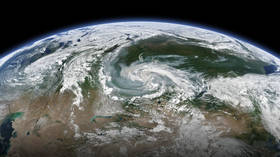‘Unprecedented’ wildfires blazing across the Arctic are visible from SPACE (IMAGES)

An unprecedented number of wildfires have been ravaging the Arctic for weeks following the hottest June ever recorded on Earth. Now, the fires are so huge and intense, the smoke can literally be seen from space.
Satellite images show more than 100 long-lived wildfires with huge plumes of swirling black smoke covering most of the Arctic Circle including parts of Russia, Siberia, Greenland and Alaska.
#TheNewNormal?Smoke vortex caused by the #Siberia#wildfiresA rough order of magnitude estimate puts the smoke-covered area at a mind boggling 2 million (yes million) square kilometres#Sentinel3 🇪🇺🛰 acquired today 24 July pic.twitter.com/6JQJcXuCSg
— Copernicus EMS (@CopernicusEMS) July 24, 2019
The wildfires have now reached “unprecedented levels,” according to Mark Parrington of the EU’s Copernicus Emergency Management Service, who said the smoke vortex is covering a “mind boggling” two million square kilometers.
Also on rt.com Siberia & Urals suffocated in smoke amid massive wildfires (VIDEOS)Wildfires are burning across 11 regions in Russia with the largest covering Irkutsk, Krasnoyarsk and Buryatia. Likely caused by lightning strikes, as of July 22 they have burned 320 square miles (829 square kilometers), 150 square miles (388 square km) and 41 square miles (106 square km) in the regions, respectively, according to NASA’s Earth Observatory.
Wildfires choking Alaska and permafrost melting 70 years ahead of schedule. 📕 Read more: https://t.co/fUqOy9fCqX#arctic#environmentpic.twitter.com/4NNW2ycu9W
— World Economic Forum (@wef) July 20, 2019
The fires have emitted 50 megatons of carbon dioxide into the atmosphere over the last six weeks, “which is equivalent to Sweden’s total annual emissions”, according to the European atmosphere monitoring service, CAMS. This staggering amount is more than was released by Arctic fires in the same month between 2010 and 2018 put together.
Record-breaking heat in #Alaska has exacerbated clusters of wildfires burning throughout the state. https://t.co/8zqVC5JAjx#NASA#MODIS#firepic.twitter.com/64zL7gYETx
— NASA Earth (@NASAEarth) July 11, 2019
“It is unusual to see fires of this scale and duration at such high latitudes in June,” Parrington said. “But temperatures in the Arctic have been increasing at a much faster rate than the global average, and warmer conditions encourage fires to grow and persist once they have been ignited.”
Like this story? Share it with a friend!















